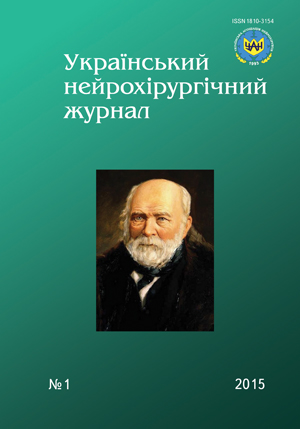Drug Gekoton in acute ischemic stroke and associated trauma, accompanied by severe brain damage
DOI:
https://doi.org/10.25305/unj.42748Keywords:
concomitant injury, ischemic stroke, HAES, GecotonAbstract
The effect of new combined polyelectrolyte colloidal hyperosmolar solution — Gekoton on plasma osmolarity, central and cerebral hemodynamics in patients with acute ischemic stroke and concomitant injury were studied. The results of clinical laboratory and instrumental tests shown that Gekoton use improved central and cerebral hemodynamics and did not cause significant changes of plasma osmolality.References
Usenko LV, Maltseva LA. Neyroreanimatologiya [Neuro intensive care]. Dnepropetrovsk: ART-PRESS; 2008.
Van Aken H, Kampmeier T, Ertmer C, Westphal M. Fluid resuscitation in patients with traumatic brain injury. Current Opinion in Anaesthesiology. 2012;25(5):563-565. CrossRef.
Reinhart K, Perner A, Sprung CL, Jaeschke R, Schortgen F, Johan Groeneveld AB, Beale R, Hartog CS. Consensus statement of the ESICM task force on colloid volume therapy in critically ill patients. Intensive Care Med. 2012;38(3):368-383. CrossRef.
Myburgh J, Mythen M. Resuscitation Fluids. Survey of Anesthesiology. 2014;58(4):164-165. CrossRef.
Ertmer C, Van Aken H. Fluid therapy in patients with brain injury: what does physiology tell us?. Critical Care. 2014;18(2):119. CrossRef.
Payen J, Vigue B, Audibert G, Bruder N. Should we ban the use of colloids in patients with head injury?. Intensive Care Med. 2012;38(9):1561-1562. CrossRef.
Ertmer C, Kampmeier T, Van Aken H. Fluid therapy in critical illness: a special focus on indication, the use of hydroxyethyl starch and its different raw materials. Curr Opin Anaesthesiol. 2013;26(3):253-60.
Downloads
Published
How to Cite
Issue
Section
License
Copyright (c) 2015 Vladimir Cherniy, Andrey Kolesnikov, V. Stasiuk, S. Chernutsky

This work is licensed under a Creative Commons Attribution 4.0 International License.
Ukrainian Neurosurgical Journal abides by the CREATIVE COMMONS copyright rights and permissions for open access journals.
Authors, who are published in this Journal, agree to the following conditions:
1. The authors reserve the right to authorship of the work and pass the first publication right of this work to the Journal under the terms of Creative Commons Attribution License, which allows others to freely distribute the published research with the obligatory reference to the authors of the original work and the first publication of the work in this Journal.
2. The authors have the right to conclude separate supplement agreements that relate to non-exclusive work distribution in the form of which it has been published by the Journal (for example, to upload the work to the online storage of the Journal or publish it as part of a monograph), provided that the reference to the first publication of the work in this Journal is included.









